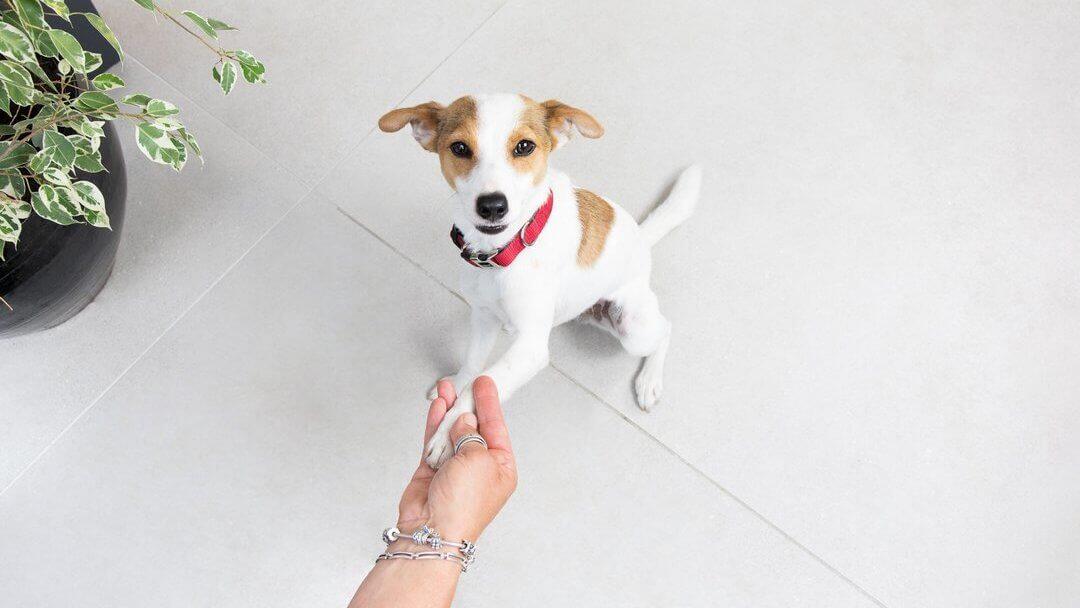
‘Playing dead’ is one of the most classic dog tricks. While it is a fun trick to amuse your friends with and show them what a good dog you have, it is very useful to have a dog who will lay on their side without you having to wrestle them there (which will cause resistance and stress) for grooming and also at the vets.
On top of both the fun and the practical parts, when you teach your dog to ‘play dead’, as with other cool tricks to teach your dog, you’re spending more time together which can help strengthen your relationship. So, do you want to learn how to teach a dog to play dead? Then, check out our easy step-by-step guide below and enjoy the process!
Why teach your dog tricks?
Having a dog is a wonderful thing and teaching them tricks is a great way of spending time together while bonding – and after all, it’s all tricks to dogs who see no difference between obedience type exercises and more fun things that you might enjoy far more. By giving them the social interactions that they need to stay happy, you’re making the teaching process a rewarding and positive experience for the both of you.
A dog who is well-trained with positive methods, who gets to spend time with their person, is a happy dog. Just watch your furry friend enjoy the stimulation and get more enthusiastic as they expand their behaviours and trick collection. Learning a variety of different tricks will also help increase their concentration, balance, stamina, and flexibility. You can add increased overall obedience to the list as well. The more time you spend together practicing, the more they’re learning to listen to you and follow your cues, knowing that a reward for a job well done is always coming.
What you need
- A quiet room free of any distractions. A quiet space indoors, with no other people or dogs present is always best when teaching your dog new tricks. Make sure there are no toys or food around as these can be distracting.
- Treats – Choose either their favourite store-bought snacks or something they love but don’t usually get, like pieces of cooked meat. These will be used as positive reinforcement to teach them what you want, encourage them in the right direction – and then reward their successes.
- A soft rug or mat – or a carpeted floor – Make the learning process as comfortable as possible. This is especially important for the ‘play dead’ trick as your dog will be lying down and rolling on their side which can hurt their joints if it is on a hard floor. Also, a hard floor can be slippery which can make changing positions difficult or even scary if they think they might slip or lose their footing.
How to teach a dog to play dead
If you’re not sure about how to teach your dog to play dead, we’ve got you covered. Follow these eleven simple steps and start practicing with your four-legged friend as soon as you can!
- Teach them how to lie down when you ask them first. If they already know it, you already have a head start.
- Ask your dog to lie down and watch to see if they tip their hip to one side. Most dog will do (either straight away or after a short while) – and note which one it is. Tipping their hips to the side is the next step in play dead and it is far easier to teach if you choose the direction your dog naturally favours.
- From the down position, show them the treat, get them interested in it by holding it by their nose, and then use the treat to bring their nose round towards the hip they are not lying on (the uppermost one) – keeping it close to their body. To follow the treat, they will have to roll over onto one hip. When they do that, give them the treat. That is the very first step mastered, as they have already shifted their weight – which will allow them to roll further onto their side.
- Practise this until your dog will tip onto one hip as soon as you lure their nose round towards their hip. Now you are ready for the next step.
- From here, use the treat to lure their head down to the ground. This can take a bit of time and confidence so have patience – as it is a vulnerable position for a dog (and for more bony dogs, not always comfortable). As soon as their head is on the ground, say your reward word (‘good’, ‘OK’… whatever you use as a success marker) and give the treat.
- Practise this a lot until you can do it all in one seamless move.
- Once you know your dog can do the movement (so go from lying down to playing dead), you can add the cue word you want to use. This could be ‘bang’ ‘flop’… again whatever you choose). This will link the action to the word.
- The next step is to remove the treat from your hand. This needs to be done gradually and your eventual aim is for your dog to lie over on their side when you just use a hand signal (such as pointing to their hip in the way you did when you were using the treat. Always reward them when they do it.
- Don’t put the cue word in until they can do the action. You need to link the cue word with the behaviour – so that in future you can just use that word. Or you might prefer to have a hand signal (such as pretending to shoot them!).
- Once they really master this trick, you can move on to asking them to ‘play dead’ from a standing position too.
- All that’s left now is practice. Lots of it. You can also carry on teaching your dog how to play dead in other places where there will be more distractions (as long as there is a soft floor). Don’t do this around other dogs unless your dog is very confident.
Five things to avoid when training your dog
Before starting training with your dog, it’s important to remember what not to do. Training is a fun activity to share with your dog, but to make sure it stays fun, there are a few things to keep in mind.
1. Training in a crowded or unsuitable space
Choosing the best spot to do the training is as important as the training itself. A quiet room will offer your dog the chance to better focus on you and not get distracted.
2. Long training sessions
Dogs have a short attention span, some shorter than others, which is why you should always keep your sessions short. A few minutes a day should be enough but pay attention to your dog’s behaviour. Cut the training short whenever you notice that they’re tired, stressed, overwhelmed, or just uninterested – but always finish with a success (even if you have to do something they can do really easily instead).
3. Not using the right treats
Treats are the magic key to the path of your dog’s learning. Probably your dog’s favourite thing in the world (excluding the time spent with you, of course), treats are a primary reinforcer and the most important incentive for learning. Choose carefully and make sure your dog loves them and really wants to work for them. In contrast, some dogs are so food oriented that the ‘very best treats’ might get them so excited, they can’t concentrate on anything at all!
4. Timing
As you are using treats for training, it is best not to schedule training sessions for directly after a mealtime, and also training takes energy, so training straight after a long tiring walk is also not a good idea.
5. Losing patience
Some dogs take more time to learn new tricks so sometimes the training might be extended to weeks instead of days. Be patient and offer them encouragement and appreciation and you’ll still notice improvements.
If you find your dog isn’t getting the hang of this trick, ask yourself if they are comfortable, if the movement is challenging for them, or if they are just not ready to learn this trick yet. Also check how you are training this trick. It’s easy to lean over your dog when you are luring them and make them feel trapped or worried.
Failures to learn are usually failures in how you are teaching. Take a step back and think if there is a better way you can ‘explain’ it to your dog – such as taking a different position, trying to roll to the other side, better treats…
Most dogs love learning new things and it’s also an opportunity for them to spend more time with you so use training as a way to strengthen your bond and have fun in the process.
Now that you know how to teach your dog to play dead, you can move on to other tricks. Learn how to teach your dog to give a paw next!












